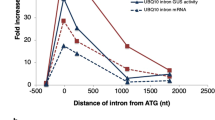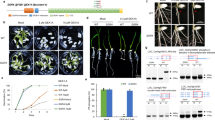Abstract
Previous studies have established that splice site selection and splicing efficiency in plants depend strongly on local compositional contrast consisting of high exon G+C content relative to high intron U content. The combinatorial model of plant intron recognition posits that splice site sequences as well as local intron and exon sequences contribute to splice site selection and splicing efficiency. Most of the previous studies used synthetic or chimeric constructs, often tested in heterologous hosts. To perform a more critical test of the combinatorial model in a native context, the single intron of the maize Bronze2 gene and its flanking exons were modified by site-directed mutagenesis. Splicing efficiency was tested in maize protoplasts. Results show that a higher U content in the flanking 5′ exon, whether close to or distant from the 5′ splice site, did not modify splicing efficiency. Decreasing exon G+C content dramatically impaired splicing. Increasing intron G+C content or decreasing intron U content adversely impacted splicing. In all constructs splicing occurred exclusively at the original 5′ and 3′ splice sites. These results are consistent with the hypothesis that exon G+C content and intron U content contribute separate but complementary aspects of intron definition in the native Bz2 transcript.
Similar content being viewed by others
References
Brendel, V., Carle-Urioste, J.C. and Walbot, V. 1998a. Intron recognition in plants. In: J. Bailey-Serres and D.R. Gallie (Eds.), A Look beyond Transcription: Mechanisms Determining mRNA Stability and Translation in Plants, American Society of Plant Physiologists, Rockville, MD. pp. 20-28.
Brendel, V., Kleffe, J., Carle-Urioste, J.C. and Walbot, V. 1998b. Prediction of splice sites in plant pre-mRNA from sequence properties. J. Mol. Biol. 276: 85-104.
Brown, J.W.S. and Simpson, C.G. 1998. Splice site selection in plant pre-mRNA splicing. Annu. Rev. Plant Plysiol. Plant Mol. Biol. 49: 77-95.
Carle-Urioste, J.C., Ko, C., Benito, M.-I. and Walbot, V. 1994. In vivo analysis of intron processing using splicing-dependent reporter gene assays. Plant Mol. Biol. 26: 1785-1795.
Carle-Urioste, J.C., Brendel, V. and Walbot, V. 1997. A combinatorial role for exon, intron and splice site sequences in splicing in maize. Plant J. 11: 1253-1263.
Christensen, A.H., Sharrock, R.A. and Quail, P.H. 1992. Maize polyubiquitin genes: structure, thermal perturbation of expression and transcript splicing, and promoter activity following transfer to protoplasts by electroporation. Plant Mol. Biol. 18: 675-689.
Filipowicz, W., Gniadkowski, M., Klahre, U. and Hong-Xiang, L. 1994. Pre-mRNA splicing in plants. In: A.I. Lamond (Ed.), Pre-mRNA Processing, R.G. Landes Company, Georgetown, TX, pp. 65-77.
Goodall, G.J. and Filipowicz, W. 1989. The AU-rich sequences present in the introns of plant nuclear pre-mRNAs are required for splicing. Cell 58: 473-483.
Goodall, G.J. and Filipowicz, W. 1991. Different effects of intron nucleotide composition and secondary structure on pre-mRNA splicing in monocot and dicot plants. EMBO J. 10: 2635-2644.
Hertel, K.J. and Maniatis, T. 1998. The function of multisite splicing enhancers. Mol. Cell 1: 449-455.
Kleffe, J., Hermann, K., Vahrson, W., Wittig, B. and Brendel, V. 1996. Logitlinear models for the prediction of splice sites in plant pre-mRNA sequences. Nucl. Acids Res. 24: 4709-1718.
Ko, C.H., Brendel, V., Taylor, R.D. and Walbot, V. 1998. U-richness is a defining feature of plant introns and may function as an intron recognition signal in maize. Plant Mol. Biol. 36: 573-583.
Luehrsen, K.R. and Walbot, V. 1994. Intron creation and polyadeny-lation in maize are directed by AU-rich RNA. Genes Dev. 8: 1117-1130.
Luehrsen, K.R., Taha, S. and Walbot, V. 1994. Nuclear pre-mRNA processing in higher plants. Prog. Nucl. Acid Res. Mol. Biol. 47: 149-193.
Manley, J.L. and Tacke, R. 1996. SR proteins and splicing control. Genes Dev. 10: 1569-1579.
McCullough, A.J., Lou, H. and Schuler, M.A. 1993. Factors affect-ing authentic 5 0 splice site selection in plant nuclei. Mol. Cell. Biol. 13: 1323-1331.
Simpson, G.G. and Filipowicz, W. 1996. Splicing of precursors to mRNA in higher plants: mechanism, regulation and sub-nuclear organisation of the spliceosomal machinery. Plant Mol. Biol. 32: 1-41.
Simpson, C.G., McQuade, C., Lyon, J. and Brown, J.W.S. 1998. Characterization of exon skipping mutants of the COP1 gene from Arabidopsis. Plant J. 15: 125-131.
Author information
Authors and Affiliations
Rights and permissions
About this article
Cite this article
Latijnhouwers, M.J., Pairoba, C.F., Brendel, V. et al. Test of the combinatorial model of intron recognition in a native maize gene. Plant Mol Biol 41, 637–644 (1999). https://doi.org/10.1023/A:1006329517740
Issue Date:
DOI: https://doi.org/10.1023/A:1006329517740




